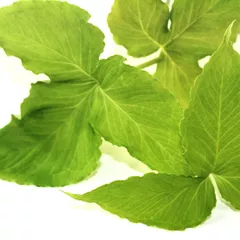Wind-Phlegm
The information provided here is not a replacement for a doctor. You shouldn't use it for the purpose of self-diagnosing or self-medicating but rather so you can have a more informed discussion with a professional TCM practitioner.
At a glance
Preliminary reading: What is a pattern? The concept of Wind The concept of Phlegm
Key attributes
Chinese name: 风痰 Pinyin name: Fēng Tán
Pattern nature: Full
Pattern hierarchy: General pattern
Diagnosis
Common symptoms: Aphasia Dizziness Coughing of phlegm Numbness in the limbs Rattling sound in the throat and one other symptoms
Pulse type(s): Wiry (Xian)
Tongue description: Swollen and deviated tongue with stick coating
Treatment
Treatment principle: Resolve Phlegm, expel Wind
Common formulas: Ban Xia Bai Zhu Tian Ma Tang
Pathology
Also known as an "upward disturbance of Wind-Phlegm", Wind-Phlegm particularly affects those who overwork, overindulge in rich foods or otherwise lead an irregular lifestyle.
These activities injure the Spleen and Stomach, which in turn impairs their functions of transforming foods, and thus leads to an accumulation of Dampness, the predecessor of Phlegm.
According to the five elements theory, when the Spleen earth is Deficient, the Liver wood becomes dominant. Its Qi ascends as Wind, carrying the Phlegm along the course of the Lesser Yang Gallbladder and Triple Burner Channels to the head. Veiling the clear Yang and disturbing the sensory orifices, it manifests as dizziness, vertigo, or headache. A distinctive feature of these head symptoms is that the head feels heavy and clouded.
The stifling sensation in the chest and the nausea or vomiting are manifestations of Phlegm obstructing the mechanisms of Qi in the chest and epigastrium. The copious sputum, white, greasy tongue coating, and wiry, slippery pulse all reflect the presence of Phlegm, Wind, and Stagnation.
Diagnosing Wind-Phlegm
Diagnosing a pattern in Chinese Medicine is no easy feat and should be left to professional practitioners. In particular one has to know how to differentiate between different types of pulses and tongue coatings, shapes and colors as well as learn to read from a long list of seemingly unrelated symptoms.
Pulse type(s): Wiry (Xian)
Tongue description: Swollen and deviated tongue with stick coating
Main symptoms: Aphasia Dizziness Coughing of phlegm Numbness in the limbs Rattling sound in the throat Feeling of oppression of the chest
Diagnosis commentary: Key characteristic symptoms of this pattern are the dizziness, chest oppression and coughing of Phlegm.
Treating Wind-Phlegm
Treatment principle
Resolve Phlegm, expel Wind
Herbal formulas used to treat Wind-Phlegm
Ban Xia Bai Zhu Tian Ma Tang
Source date: 1732 AD
Number of ingredients: 8 herbs
Key actions: Dries and dissolves Phlegm. Strengthens the Spleen. Smoothes the Liver and calms Liver Wind (antispasmodic).
Formula summary
Ban Xia Bai Zhu Tian Ma Tang is a 8-ingredient Chinese Medicine formula. Invented in 1732 AD, it belongs to the category of formulas that transform Phlegm and extinguish Wind.
Besides Wind-Phlegm, Ban Xia Bai Zhu Tian Ma Tang is also used to treat Phlegm.
Diet recommendations
Since Wind-Phlegm is often due to an overindulgence in rich foods, it stands to reason that one should change their diet towards light foods.
Related conditions
Please keep in mind that a Western Medicine condition can be caused by several Chinese Medicine patterns of disharmony and vice versa. As such a patient suffering from one of the conditions below will not necessarily be suffering from Wind-Phlegm, it is just one pattern that's commonly associated with the condition. Click on a condition to learn what other patterns it's associated with.
Hypertension Meniere's disease Tubercular meningitis Benign positional vertigo



